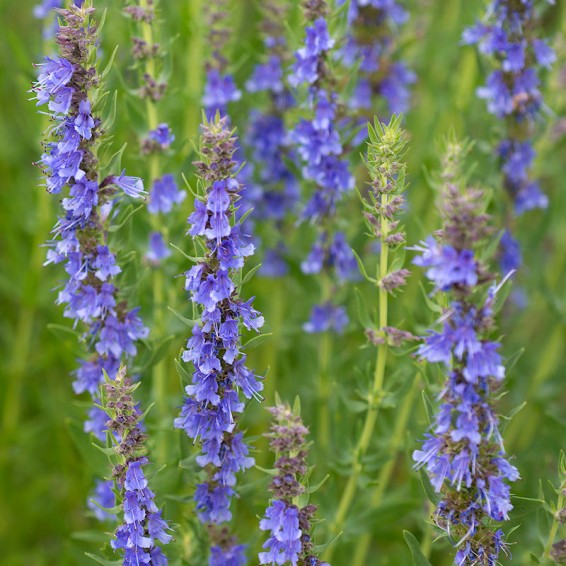Organic Hyssop Seeds
- HOW TO GROW
- FAST FACTS
- REVIEWS
HOW TO GROW
Sowing: Hyssop thrives in light, well drained soil and full sun or partial shade, and should be planted after the last frost of spring. It can also be planted in late fall for spring germination. Since the seeds need light to germinate, sow them on the surface of the soil 6" apart and thin them to 12" when the seedlings appear. Germination may take as long as 3-4 weeks. For companion planting benefits, plant hyssop near cabbages or grapevines, but not radishes. Hyssop also makes an excellent border, hedge, or container plant because of its attractive blooms and bushy, compact growing habit; this herb attracts many bees, hummingbirds, and butterflies.
Growing: Do not over water, since this herb prefers slightly dry soil. Hyssop resists nearly all pests and diseases. Before the spring growth, prune the plant heavily for healthy, tender new stems.
Harvesting: Harvest leaves for fresh use as soon as they reach a desirable size. The best time for harvesting is the morning after the dew has dried. Though both the leaves and flowers can be used as an herb or a flavoring, the flavor of the leaves is stronger than that of the flowers. Entire stalks can be harvested as soon as the flowers begin to open, and hung upside down to dry; they should be dried quickly and away from direct sunlight. Once dried, remove the leaves and flowers from the stem and store in an airtight container.
Seed Saving: In the late summer, the flowers will fade and the seeds begin to develop. Remove the stalks individually as they ripen, and spread them out to dry away from direct sunlight. Shake them to remove the seed. Store the seed in a cool, dry place.
FAST FACTS
Latin Name: Hyssopus officinalis
Type: Open Pollinated, Heirloom, Cool Season|Warm Season
Life Cycle: Perennial
USDA Zones: 3, 4, 5, 6, 7, 8, 9, 10, 11, 12
Seeds per Ounce: 50,000
Planting Method: From Transplant
Planting Depth: 0.1
Planting Spacing: 20
Days to Maturity: 180
Sunlight: Full Sun
Height: 20 Inches
Color: Purple
Bloom Season: Blooms Late Summer
Uses: Attracts Pollinators, Attracts Honeybees, Attracts Butterflies, Aromatic
Great
Very pretty plant and easy too start
DESCRIPTION
HOW TO GROW
Sowing: Hyssop thrives in light, well drained soil and full sun or partial shade, and should be planted after the last frost of spring. It can also be planted in late fall for spring germination. Since the seeds need light to germinate, sow them on the surface of the soil 6" apart and thin them to 12" when the seedlings appear. Germination may take as long as 3-4 weeks. For companion planting benefits, plant hyssop near cabbages or grapevines, but not radishes. Hyssop also makes an excellent border, hedge, or container plant because of its attractive blooms and bushy, compact growing habit; this herb attracts many bees, hummingbirds, and butterflies.
Growing: Do not over water, since this herb prefers slightly dry soil. Hyssop resists nearly all pests and diseases. Before the spring growth, prune the plant heavily for healthy, tender new stems.
Harvesting: Harvest leaves for fresh use as soon as they reach a desirable size. The best time for harvesting is the morning after the dew has dried. Though both the leaves and flowers can be used as an herb or a flavoring, the flavor of the leaves is stronger than that of the flowers. Entire stalks can be harvested as soon as the flowers begin to open, and hung upside down to dry; they should be dried quickly and away from direct sunlight. Once dried, remove the leaves and flowers from the stem and store in an airtight container.
Seed Saving: In the late summer, the flowers will fade and the seeds begin to develop. Remove the stalks individually as they ripen, and spread them out to dry away from direct sunlight. Shake them to remove the seed. Store the seed in a cool, dry place.
FAST FACTS
Latin Name: Hyssopus officinalis
Type: Open Pollinated, Heirloom, Cool Season|Warm Season
Life Cycle: Perennial
USDA Zones: 3, 4, 5, 6, 7, 8, 9, 10, 11, 12
Seeds per Ounce: 50,000
Planting Method: From Transplant
Planting Depth: 0.1
Planting Spacing: 20
Days to Maturity: 180
Sunlight: Full Sun
Height: 20 Inches
Color: Purple
Bloom Season: Blooms Late Summer
Uses: Attracts Pollinators, Attracts Honeybees, Attracts Butterflies, Aromatic
Reviews
Review
Great
Very pretty plant and easy too start





